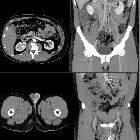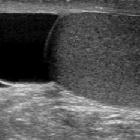azoospermia

Azoospermia refers to complete absence of sperm in the semen. It accounts for 5-10% of male infertility.
Pathology
It can be obstructive or non-obstructive, e.g. primary testicular failure. This differentiation is of utmost importance, as obstructive azoospermia can be corrected by surgical intervention.
Etiology
Obstructive azoospermia
- congenital bilateral absence of ductus (vas) deferens (CBAVD)
- obstruction of ductus deferens
- tubular ectasia of rete testes or epididymis
- inflammatory lesion of epididymis or ductus deferens.
- inflammatory obstruction of ejaculatory duct
- iatrogenic injury (vasectomy, hernia repair etc)
- varicocele (controversial, if it causes azoospermia)
Non-obstructive azoospermia (primary testicular failure)
- Klinefelter syndrome
- Y microdeletion
- unexpained testicular failure
Radiographic assessment
Ultrasound
Scrotal ultrasound
Sonographic features that may be present with azoospermia include:
- ectasia of rete testes: anechoic tubular structures in mediastinum testes.
- tubular ectasia of epididymis: multiple anechoic tubular structures in epididymis head (the differential for this feauture includes spermatocele, epididymal cyst)
- inflammatory epididymal mass: enlarged heterogenous epididymis head.
- testicular volume: small sized testes (<7 cc) is seen in primary testicular failure. However, testicular volume is usually larger (>13 cc) in obstructive azoospermia
Transrectal ultrasound
Sonographic features that may present on transrectal ultrasound include:
- absence of ductus deferens
- dilated ductus deferens (diameter >1.5 mm)
- hypoplastic seminal vesicles (transverse diameter <7 mm and length <16 mm)
- dilated seminal vesicles (transverse diameter >15 mm and length >25 mm)
- inflammatory cyst(s) in ejaculatory duct
MRI
Similar features like absence or ductus deferens or seminal vesicle can be seen on MRI. Epididymal and seminal vesicle cysts can also be well seen. Endorectal MRI is the preferred modality.
Fluoroscopy
Vasography (vasculodeferentography) has rare application now, however, theoretically stays the gold standard to evaluate obstructive azoospermia.
Treatment and prognosis
Patients with primary testicular failure (non-obstructive azoospermia) benefit from intracytoplasmic sperm injection. Obstructive azoospermia patients benefit from surgical correction such as vasoepididymostomy. Also, we can obtain sperm directly from epididymis or seminal vesicle, in cases of obstructive azoospermia.
Siehe auch:
und weiter:

 Assoziationen und Differentialdiagnosen zu azoospermia:
Assoziationen und Differentialdiagnosen zu azoospermia:



